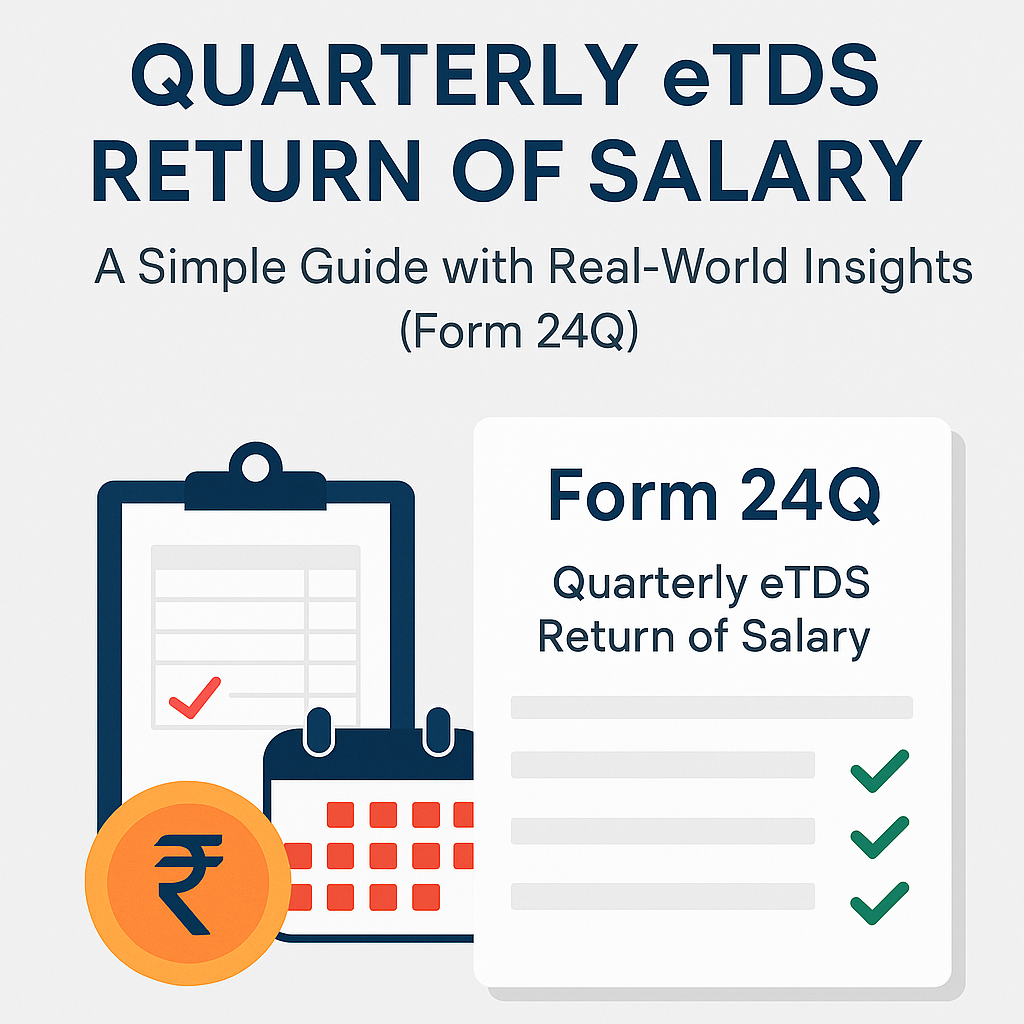Imagine you’re a Payroll Manager named Ritu. It’s the end of June, and your inbox is full of reminders—“Submit Q1 eTDS Return!”, “Form 24Q due soon!”, “Have you filed for all PAN holders?”
If you’re handling payroll in India, then you know how serious and time-sensitive quarterly eTDS returns are. But don’t worry. This guide will help you understand:
- What is Form 24Q?
- Why are eTDS returns filed quarterly?
- Step-by-step filing process
- Penalties for delay
- Common mistakes to avoid
- Screenshots for each step
What is Quarterly eTDS Return (Form 24Q)
eTDS (Electronic Tax Deducted at Source) is the online method of filing TDS returns to the Income Tax Department.
When you deduct TDS from employee salaries every month, you must report it quarterly using Form 24Q. This is a salary-specific TDS return form under Section 192 of the Income Tax Act.

Who Needs to File Form 24Q?
Any employer—whether company, partnership, proprietorship, or government—who deducts TDS on salary payments must file Form 24Q every quarter.
So whether you run a big MNC or a small HR consultancy, once you’re deducting tax from salaries, you must file 24Q.

Structure of Form 24Q
Form 24Q has two annexures:
Part A – Challan Details
Contains:
- TDS payment details (via challans)
- BSR code of the bank
- Date of deposit
- Challan serial number
- Amount
Part B – Employee Salary Details
Contains:
- PAN of employees
- Salary details
- TDS deducted and deposited
- Other income (declared)
- Deductions (like under Section 80C)
Note: Part B is mandatory only in Q4 with complete breakup of annual salary and tax computation.
Step-by-Step Process of Filing Quarterly eTDS (Form 24Q)
Here’s how Ritu (our fictional payroll manager) files 24Q:
Step 1: Collect Employee Data
Make sure you have:
- PAN of all employees
- Their salary structure
- Deductions and exemptions
- Declaration of other income
- Investment proofs
Step 2: Deduct TDS Every Month
TDS must be deducted at the time of salary payment and deposited to the Central Government’s account via Challan 281.
Step 3: Use RPU (Return Preparation Utility)
Download the latest RPU (Return Preparation Utility) from TIN NSDL Website.
Fill in:
- Basic details (TAN, PAN, Assessment Year)
- Challan details
- Employee-wise TDS data
Step 4: Validate Using FVU (File Validation Utility)
After preparing your return, use FVU utility to:
- Validate your .txt file
- Check for errors (PAN missing, mismatch, etc.)
If validation is successful, you’ll get a .fvu file ready for submission.
Step 5: Submit to TIN-FC or Upload Online
a. Offline Submission:
- Copy the validated FVU file to a CD/Pen Drive
- Submit to any TIN Facilitation Centre (TIN-FC)
b. Online Submission via TRACES/e-Filing Portal:
- Login using TAN on e-Filing Portal
- Upload FVU file using DSC or EVC
Step 6: Download Form 16 (After Q4)
Once the Form 24Q for Q4 is filed and processed, you can generate and issue Form 16 to employees.
Form 16 has:
- Part A: TDS Summary
- Part B: Salary Breakup and Tax Computation

Always keep a reminder set in your payroll calendar!
Penalty for Late Filing
Nobody likes paying penalties. But if you delay or forget, here’s what happens:

Common Mistakes to Avoid
❌ PAN not matching with database
❌ Delay in TDS payment
❌ Using old version of RPU/FVU
❌ Incorrect challan details
❌ Filing wrong quarter (Q2 instead of Q3)
❌ Missing salary breakup in Q4
Always verify your PANs via NSDL PAN verification tool before filing.
Example:
Let’s say, Ritu paid ₹80,000 monthly salary to 10 employees from April to June 2025. TDS @10% is deducted monthly = ₹8,000 per person.
So:
- Total salary paid = ₹24,00,000
- TDS deducted = ₹2,40,000
- TDS deposited via Challan 281 monthly
- On or before 31st July 2025, she must file Form 24Q for Q1
- In Q4, full salary breakup and deductions will be shown
Frequently Asked Questions (FAQs)
Q1. Is Form 24Q mandatory for all employers?
Yes, if you deduct TDS on salary, it is compulsory.
Q2. What if I paid salary but didn’t deduct TDS?
You should still file Nil TDS return with zero deduction, else you may get a notice.
Q3. Can we revise Form 24Q?
Yes. You can file a revised return if there are errors or corrections needed.
Q4. What is the format of the salary details in Part B?
It includes:
- Basic Salary
- HRA
- Allowances
- Deductions under Section 80C, 80D, etc.
- Net taxable income


66332 975580Spot up for this write-up, I truly feel this exceptional internet site requirements a great deal more consideration. Ill a lot more likely be once again to read considerably far more, thank you that details. 297160
866321 540979Spot up for this write-up, I truly feel this superb website requirements a whole lot far more consideration. Ill much more likely be once once again to read considerably much more, thank you that data. 789623
755037 855287There is an ending. Just remember that I meant for this to be an art game. I do feel like I spent an inordinate amount of time on the far more traditional gameplay elements, which may make the meaning with the game a bit unclear. In case you mess about with it though, you will uncover it. 418910
684905 578168Basically wanna input on few common items, The website layout is perfect, the articles is really great : D. 409863
411198 567108Hi, Neat post. Theres a problem with your website in internet explorer, would test this IE still may be the market leader and a big portion of people will miss your amazing writing because of this dilemma. 124706
Sweet internet site, super layout, very clean and apply genial.
kuwin sở hữu kho game đa dạng từ slot đến trò chơi bài đổi thưởng, mang đến cho bạn những giây phút giải trí tuyệt vời.
搭载智能站群程序,自动化搭建与管理,为SEO项目提供核心驱动力。站群程序